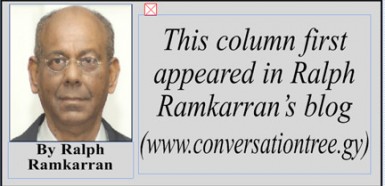The results of the local government elections should give no political comfort to our political parties. The PPP won 48 out of 71 NDC elections, similar to 1994 when it won 48 out of 65 and 28,000 more votes than the APNU+AFC. The APNU+AFC won 5 municipalities, the PPP 3 and 1 is a tie. The turnout at the local government elections was low, at least lower than the national elections, as occurs almost everywhere, and it is therefore unsafe to make any enduring political conclusions from the results. But some glaring issues have emerged.
 In the 1994 local government elections for the George-town municipality the PPP/Civic won 8 of the 30 seats. The GGG (Good and Green Guyana) won 12 and the PNC 10, a total of 22. In these elections the PPP won only 2 seats. There was a suggestion that the result was a consequence of the PPP/C government’s abandonment of the city. While this may have played a role, these types of failures have only a marginal impact on our rigid ethnic voting patterns. The PNC’s 40 per cent of the vote at the 1992 elections when every political indicator suggested that it should have been wiped out proves the point.
In the 1994 local government elections for the George-town municipality the PPP/Civic won 8 of the 30 seats. The GGG (Good and Green Guyana) won 12 and the PNC 10, a total of 22. In these elections the PPP won only 2 seats. There was a suggestion that the result was a consequence of the PPP/C government’s abandonment of the city. While this may have played a role, these types of failures have only a marginal impact on our rigid ethnic voting patterns. The PNC’s 40 per cent of the vote at the 1992 elections when every political indicator suggested that it should have been wiped out proves the point.
But experiences have shown that the ‘rigid ethnic voting patterns’ can be modified, especially when some disgruntled party supporters are swayed by what they see as a credible third force. In 1961 and 1964 a section of the Indian business and middle class abandoned the PPP and voted for the United Force. In 2006 a sizeable section of the African middle and working class abandoned the PNCR and supported the newly formed AFC. In 2011 and 2015, sections of the PPP’s Indian support abandoned it, some for the AFC and some by not voting at all.
The PPP’s total collapse in the City of Georgetown confirms what many have long suspected, namely, that the PPP has lost the support of the business, professional and some of the middle class. Located in significant numbers, though not exclusively, in the city these groups appear to have supported some other party or group, or as is more likely, to have declined to vote. This would not be easily discerned in the rural areas where the PPP is strong. The overall low turnout and a result similar to that of 1994 would not indicate if any pockets of business and other middle class supporters stayed at home.
If the above analysis is accurate, this would be the third successive elections where this section of PPP supporters has abandoned it. To be truthful, they were always tentative. As above stated, they migrated to the UF in the 1960s, may have migrated in part to the PNC in the 1970s and 1980s, although there are no accurate election results to determine this, and returned to the PPP in 1992. Thereafter some have supported the AFC or stayed at home.
The results for APNU+AFC show no breakthrough in PPP areas of support. The NDC results for the PPP, identical to 1994, show no penetration by the APNU+APC in PPP areas as in 2011 and 2015. The results do not discourage the idea that the AFC has lost considerable ground. If this is so, it would not be unusual for third parties in Guyana. The UF ceased to be an effective political force at the end of the 1960s. The mighty WPA, which never had the opportunity to prove its electoral strength because of electoral malpractice, has faded from view, leaving only the idealism of its founders.
These conclusions of necessity are tenuous because of the low turnout and the consciousness among voters that conclusive political opinions are not always expressed in local government elections. An example was headlined in SN yesterday. A pro-government group, Kwakwani United for Progress, captured 5 out of 12 seats. APNU+AFC obtained 7. Thus while some voters might have been swayed in ways that do not necessarily demonstrate their definitive political opinion, the PPP itself did not think so having regard to its declaration of a ‘massive’ victory.
If the AFC fades and the Indian business, professional and other groups of the middle class remain alienated from the PPP, the PPP will retain the advantage in national elections in a two-party race and could well be restored to office on a majority of fifty per cent plus, assuming free and fair elections. Unless, of course, another and a different kind of third party, that would decline government office or power, takes up the challenge to represent the interests of the Guyana electorate in the National Assembly, pledging to support the party with modernized programmes for social and economic justice and development, particularly for the poor and disadvantaged, based on constitutional reform designed to engender national unity.
Disaffected PPP supporters, tired of the sterile political confrontations of the past 50 plus years and anxious for a credible vision for the future in a united, peaceful, progressive, developing and stable country, would find it hard to resist such an appeal.





